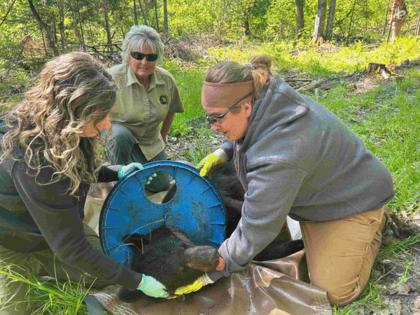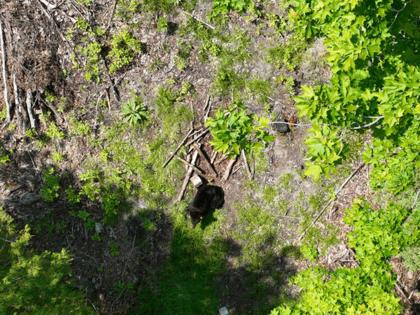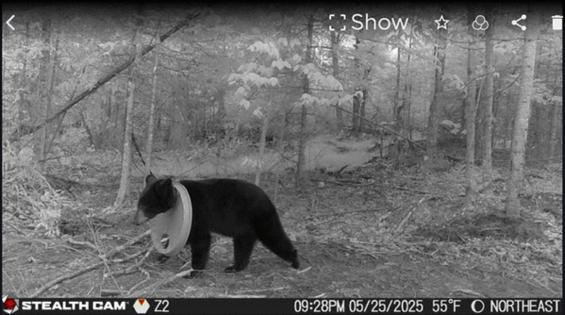After 2 years with a lid stuck on its neck, a Michigan black bear is finally free
Published in News & Features
DETROIT — After evading authorities on a two-year-long manhunt, an elusive black bear has finally been caught in northern Michigan.
The young black bear, which has been carrying a lid stuck around its neck since 2023, was captured by state wildlife biologists in Montmorency County in early June, the Michigan Department of Natural Resources announced Wednesday.
The biologists removed the lid.
"It's not a super common occurrence, but occasionally we do get like trail camera photos submitted to us of a bear or other wildlife with their heads stuck in either lids or containers similar to this," Cody Norton, the DNR’s bear, furbearer and small game specialist, told The Detroit News. "A lot of times, those animals might be in very remote areas and we might not be able to catch up to him."
Though authorities don't know how the male bear came to get its head stuck in the 5-inch hole of the lid, they learned it was a blue plastic piece similar to those that fit 55-gallon drums used by hunters to bait bears or landowners to store materials such as chicken feed that can attract the animals.
Biologists at the DNR’s Atlanta field office first became aware of the bear in 2023 after seeing trail camera photos of the then-cub with its head stuck in the lid. The bear would prove elusive over the next two years, occasionally appearing on other trail camera photos but then disappearing after a day or so.
In a turn of events, in late May, a Hillman resident spotted the bear in trail camera footage taken on his wooded acreage and alerted the DNR. With the landowner’s permission, state biologists set up a baited enclosure trap and caught the animal safely on June 2, DNR officials said.
"We want to be able to help individual animals when things like this occur," Norton said. "From our standpoint, we wanted to try to intervene when it's a human-caused issue that's impacting wildlife, but it also provided a really good opportunity for our staff to get training and experience in chemical mobilization of wildlife."
There were several staff members involved in trapping the bear and chemically immobilizing it, allowing them to perform a full workup and get experience, Norton said. After anesthetizing the bear, biologists cut the lid off its neck and collected body measurements and other data.
The bear weighed 110 pounds, which biologists say is typical for a 2-year-old still growing. Officials said it had significant scarring and an abscess on its neck but seemed healthy otherwise. The bear was released back onto the property once the anesthesia wore off.
According to Norton, the trapping, chemical immobilizing and data-collecting effort provided DNR staff with valuable training and information that can inform future research and bear-management strategies.
"These are great opportunities, just for us to kind of knock the dust off," Norton said. "And then I think too, being able to get the lid in hand, see how it's impacting the bear, get measurements on those diameters that can help inform regulations for bear hunting. We don't know where this lid came from, or that it had anything to do with hunting, but the Natural Resources Commission has authority over method and manner of taking bears, and the department makes recommendations to them over how we're setting what regulation changes we need."
Michigan is home to about 13,000 black bears, with 1,700 of them in the northern Lower Peninsula, DNR officials said.
Baiting is a legal method for hunting bears in Michigan, department officials said, but bait containers can only be used on private land and have holes that are either 1 inch or less in diameter, or 22 inches or greater in diameter.
To avoid similar incidents, landowners can do their part by recycling or crushing containers such as empty cheeseball tubs and being “BearWise” about securing garbage, Norton said.
Beyond the situation in Michigan this month, there are other cases, like in Florida, Wisconsin and Tennessee, where bears got their heads stuck in food containers, Norton pointed out.
“Container openings of a certain size can result in bears and other wildlife getting their heads or other body parts stuck in them, leading to injury or death,” Norton said in a statement. “It’s important to remember that the opening diameter is more important than the size of the container.”
_____
©2025 The Detroit News. Visit detroitnews.com. Distributed by Tribune Content Agency, LLC.












Comments